The situations which I most frequently need to use a microphone are in live bands (such as with Payazen! or other jazz/pop ensembles) and with electronics. I wanted a clip-on mic for Payazen! because I didn’t like being tied to a single point on stage with mics on a stand. I wanted to be able to move around more and look at my bandmates without it affecting the amplification.
I had a list of several requirements of a microphone:
- 2 mic capsules
- single output
- multi-instrument compatibility (clarinet, bass clarinet, and if possible, saxophones)
- quickly swappable between instruments
- wireless-capable
However, to reap levitra 20mg australia out maximum benefits, it is a healthy alternative to the PDE-5 medicines. As the penis get canadian pharmacies tadalafil erect with the dosage of Silagra the arteries in the penile region gets erect and hard. These are the part of the male cheapest generic levitra reproductive system. It has been prepared with the sildenafil treats erectile dysfunction after improving the blood circulation and curing the damaged blood vessels. india tadalafil tablets
Micing a clarinet, and especially a bass clarinet, is difficult. The sound doesn’t come from one place like from a brass instrument. And contrary to the popular belief of nearly every live sound and recording engineer I’ve encountered that is inexperienced with bass clarinets, the sound is not coming out of the bell. The bell merely amplifies the sound, and primarily only the notes closest to it, but the majority of the sound is coming out the first available open hole, which can span the whole length of the instrument. That’s fundamental in how the clarinet works. Saxophones usually get mic’ed just from the bell, but that works better because of the shape of the instrument (the bell comes back halfway up the horn), and because it’s conical. This does not work for bass clarinet!
With a clarinet you can get away with using a single mic (although two is still better), but a bass clarinet (especially a low C instrument) really needs to have two in order to get even coverage of the whole instrument. This presents a challenge when looking for a solution for microphone systems. Compounding this problem is that I only wanted a single output, however with two mics, naturally you would need two outputs. So I had to find a solution that mixed the two signals and sent it out as only one. In Payazen! I’m frequently switching between clarinet and bass clarinet mid-song and only have a few bars to make a change, so a mic that works with both instruments and can be swapped quickly was crucial. Wireless capability was also ideal, but a little less so. Being completely free from wires is great on stage, but I can deal with having them. With electronics it’s even less important to be wireless because I’m often situated in a fairly static position in order to use the computer or other controllers, but wireless would be necessary if I needed to have a mic in a theater setting where I am moving on stage. Luckily, many professional instrument mics have wireless capabilities.
I decided on the TA2 *(see UPDATE footnote) model from Applied Microphone Technology (AMT), and have been using it for about a year at the time of writing. It’s marketed as a soprano and baritone sax mic, although every photo from the company only shows it being used on a soprano, and it’s probably better designed for a low Bb bari rather than a low A. I went with this one because it was able to fill ALL of my requirements. It has two capsules on goosenecks with a clip designed to attach to the bell of a soprano sax. The angle of the clip is adjustable with a small hex-key that comes with the mic, and is spring-loaded with a notch for the edge of the bell and has a screw to tighten it securely. One mic gets positioned at the bell and the other between the two hands on the body. The mics are mixed internally and sent out a single output with a mini-XLR cable to the BP45 beltpack which can supply phantom power with a AA battery. A switch enables a flat response or a bass roll-off, or the beltpack can be turned off to receive phantom power from an external preamp through an XLR cable. Rather than a beltpack, an inline preamp is also available, but then phantom power is required from an external source. AMT also has an optional wireless system, the Wi5 series, designed to be used with any of their mics. I think this is one of the nicest wireless system designs I’ve seen, because rather than the microphone attaching to a beltpack transmitter, the Wi5 transmitter clips directly to the mic! So not only are you free from a long cable attaching you to the stage somewhere but you’re also free from a cable attaching you to the instrument.
Clarinets
The only obstacle to overcome was how to use this mic with all my instruments. As it’s designed for a soprano sax, it’s quite logical how it should be set up for clarinet. However, the clip is designed for the thin metal ridge of a saxophone bell, not the thick wood of a clarinet, so I had to create a fake edge that it could attach to. My first solution was creating a sort of clamp with a strip of aluminum. I curved it around end of the bell and created two tabs on either end with holes for a screw and wingnut to tighten it down. Then I attached a small “L” bracket on the top side and covered everything with plastic tape to prevent scratching and give it more grip. This worked… more or less. The clamp sometimes slipped and I was always wary of tightening it too much and damaging the bell. If I didn’t get it in the right position it also affected how the clarinet sat on a stand, or the stand would knock it out of place. I considered cutting out a groove along the inside circumference of the clamp where the edge of the bell could sit better. You can also see in the picture that after some time the tape began to tear.
But then I found another solution. This thing… from Thomann.de is designed for some sort of AKG mic that seems to be discontinued, but is exactly what I needed. It has a clamp to go around the top part of the bell, like a marching lyre, and then a metal plate sticking out a few centimeters. A good start, but doesn’t quite get to the edge of the bell. It’s quite sturdy and doesn’t bend or flex, and also has a couple holes for mounting the mic it’s designed for. I used one of these holes to attach a longer “L” bracket to extend it closer to the edge of the bell and I cut off the side sticking out to the length I needed it to be to attach the TA2’s clip. I managed to get the bracket to extend out just as far as it would be able to reach before the bell’s flare interferes, and put some soft foam with a sticky side (designed for doorway insulation) on the bottom side to prevent scratching the bell. Perfect! Rather than buying the clamp from Thomann, a similar device could also be made from a strip of aluminum, basically creating the original clamp I made but much smaller to fit around the top of the bell. I’ll admit, with the mic, the extra pieces of metal for the bracket, and the wireless transmitter, it does add some weight… but there’s always a sacrifice somewhere. And this would be a problem with most microphones anyway.
This clamp also works for my A and C clarinets, however since the bell of the C is shorter and flares sooner I would need to use a slightly shorter “L” bracket. The diameter of my Eb clarinet is too small at the joint of my stock bell, but my Backun bell is actually wider here than my Bb clarinet bell, so I am able to attach the clamp on it. But if I wanted to use my stock bell I would need to find a different solution. By shortening the “L” bracket I can attach the mic in the right position. The upper mic then extends to around my throat “A” key, which is too high, but by angling it with the gooseneck back towards the holes I achieve good coverage. In my testing, there’s a very slight drop in volume around the clarion D and E, but overall quite good.
The challenge with bass clarinet was a bit different. It already has the right type of bell, so initially no problem there, but the issue is more that the bell is a bit low on a low C instrument, so the top mic doesn’t quite get to the ideal position. By attaching the mic as much on the inside of the bell as I can gets it pretty close, but then the bottom mic also isn’t in a very good position to be aimed over the bell. It’s a bit too close and ends up sitting more inside the bell than it should, resulting in very deep blasts on the low notes, so I positioned it over the low pads leading to the bell. Overall, this was working for me. I angled the top mic a bit up, and by keeping a bit of distance away from the instrument it picks up most notes fairly well. I had to position the bottom mic so it’s not directly in front of one hole and getting blasted whenever I play that note, but just off to the side is pretty good. I used it this way for a while, but there were some volume differences as I played up and down the horn, particularly with the right hand notes in both the chalumeau and clarion registers being a bit weak and thin sounding. I wanted a solution to get it into an even better position about 10cm higher, but the problem was creating a place to clip the mic to. With so much keywork on the bass clarinet it’s quite difficult to find a way to do this. AMT does make a bass clarinet clamp for their LS microphone, but I was not sure how much extra weight it would add, or if the TA2 could properly clamp to it. And I didn’t want to spend $130 for it to not work.
My solution was to repurpose the first clarinet clamp I made. I took two small blocks of wood and cut out a curve on each to match the circumference of the bass clarinet and attached some packaging foam to prevent scratching. I attached the blocks on either side of the inside of the clamp, and am able to fasten it to the body of the bass clarinet just under my low Eb pad securely and without damaging the wood. The clamp goes around all of the keywork without interfering, and is easily removable. It’s very strong and sturdy and now holds the microphone in the perfect position. The top mic comes up to just above the middle joint, which I then angle slightly down, and the bottom mic hangs a few centimeters above the bell. Now I have even coverage throughout the whole range of the bass clarinet.
With this setup, I’m able to switch it from clarinet to bass clarinet quickly by just opening the clip and moving it to the other horn. The tabs of the “L” bracket where the microphone clips on both the clarinet and bass clarinet clamp are at the same angle relative to the instrument, so I don’t have to change the angle of the clip. Some adjustment has to be made to the angle of the goosenecks, but that can be done within seconds.
On my alto clarinet I’ve managed to get quite good results by attaching the clip to the bottom side of the bell. The top mic reaches up the the left hand, but by curving the gooseneck a bit I can get it to point right about at the middle joint and angle it slightly down. The bottom mic doesn’t really point anywhere except the lowest pad, but the sound is very even throughout. In fact, I think I achieve the most even sound with the alto clarinet compared to all the rest. My guess is that this is due to the bell directing the sound back up while being considerably shorter than the bass clarinet. I think the alto could actually get away with using a single microphone system as long as it extended high enough.
Saxophones
Using the mic for saxophones came as a second thought. I’m not playing nearly as much sax as clarinets these days, but it does come up sometimes. And coincidentally, at the time of writing, I happen to be playing tenor for a few gigs with a pop band where I will need it.
As it turns out, the TA2 is also usable on alto, tenor, and baritone saxophones *(see UPDATE footnote). As mentioned before, it’s marketed as also being for bari, but I haven’t seen any photos being used this way. I imagine the way they intend it to be used is in a position similar to how I have it on the bass clarinet with the clamp, by clipping it to top part of the bell, the part closest to the player, with the lower mic pointed down into the bell and the upper mic up at the keys. On my low A horn, the bell comes all the way back up to my left hand, so the top mic is way too long to be used like that. With a low Bb horn, it might be in a good place. So on all of my saxophones I positioned it clipped to the side and angled the top mic down into the bell and let the bottom mic find a position by the lower pads, like how I used to with bass clarinet before making the clamp.
I get an even coverage all the way up and down the horns on alto, tenor, and baritone. As I said before, micing a sax is much easier because most of the sound is actually coming out of the bell. So as long as I had the top mic pointed there it was fine, with the bottom mic just grabbing some extra sound. I also tried attaching it to the front side of the bell, furthest away from the player, because the lower pads are angled towards the front of the horn. I wondered if it would make a difference in the sound picked up by the bottom mic. Although, while this may affect the lowest pads on the saxophone, it wouldn’t help to pick up more sound from the finger pads. In any case, I didn’t hear any appreciable difference. There’s an even coverage all along the horns in both positions. With the adjustable angle of the clip and the two goosenecks it’s quite flexible and you can find the best position for each horn.
Wireless
I’ve just recently managed to get ahold of the Wi5 wireless system second hand. It has 16 different selectable channels and outputs on jack or XLR. The transmitter uses a AAA battery, has a switch for On/Off/Mute and, as I said before, clips directly onto the microphone. I think it’s great because it leaves me completely wire-free from the instrument. The newer model is the Wi5II and has 99 selectable channels with frequency variations, the receiver can accept signal from 2 transmitters, and the transmitter has a built-in rechargeable battery. AMT mics will also work with wireless systems from some other manufacturers like Shure and Sennheiser.
Even better, I’ve managed to get everything to store in the box that the TA2 came in. The mic, the beltpack, the mini-XLR cable, the small hex-key, the ZR1 wireless receiver, its power adapter, the Wi5 transmitter, the clarinet clamp I made (but not the bass clarinet clamp), and extra AA and AAA batteries all fit into the box that otherwise would only hold the microphone. I can be prepared to play wired or wirelessly without having to take up any extra space. I knew all those hours of Tetris would be good for something.
Performance
I’ve been using the TA2 for nearly a year now, and I’ve been quite happy with it. The sound is great, it’s quite lightweight, and easy to set up. It’s important to experiment with different positions to find what sounds best in different situations. Each microphone is suspended with elastic, but I sometimes get a bit of low rumble from the instrument moving while playing. This can be minimized by using the low roll-off on the beltpack, or by some EQing from the sound engineer. I notice it the most while listening through headphones or recording, but not while playing live.
The mics are also quite sensitive so feedback can be a problem. This is true any time condenser microphones are used on stage. They have a hypercardiod pick-up pattern, so as long as they stay pointed away from monitor speakers it’s ok. The top mic is tuned about 7dB louder and both have about 2-3dB lifts around 100, 1200, and 6000 hz.
AMT makes another preamp, the AP40 “Studio”, that I presume is a low-noise preamp designed for studio recordings, but there’s no extra noise or hum that I hear while using the beltpack. The ZR1 wireless does introduce a bit into the signal, so I wouldn’t use this for recording, but a wireless unit shouldn’t be used for recordings anyway.
The battery life on the beltpack is quite long. I think I’ve only replaced it once so far, and that was after accidentally leaving it switched on with the mic plugged in for a couple days. If the mic isn’t attached there seems to be no battery drain even if it’s in one of the on positions. I do sometimes use phantom power from a mixer or soundcard, so I don’t have an accurate measure of exactly how long one battery will last, but so far it’s been fine. The wireless, however, is a different story. In the short time I’ve had it, I think I’m getting a few hours per battery which is enough for a couple gigs. I use rechargeables, so have to remember to recharge them before playing, but also carry extra ones with me for emergencies. I just always make a habit of switching off the transmitter whenever I’m not using it or playing.
I think the clip itself could be a bit bigger and stronger. On metal bell edges it’s fairly secure just clipped on without the screw tightened, but it can bounce a bit. If the clip itself was a bit bigger this might be less of a problem and it would be more stable. The screw could then clamp down just as extra security, rather than being a bit of a necessity. On the clamps I’ve made, the “L” bracket is just as wide as the clip, so it is rather necessary to tighten the screw or it’s liable to fall off if it tilts too far too one side or the other. Adding a small ridge on the end of the “L” bracket to fit into the notch on the clip could help with this.
Other Microphone Options
The intention of this post is not to say that this is the best microphone for everyone. There are several other possibilities and manufacturers that make very good mics, but they just didn’t work for me for various reasons. Other mics I looked at included the SD Systems LCM82B, which many professionals I know use. This is designed specifically for bass clarinet with two independent mics that each plug into a single beltpack that mixes the signal to one output, with a knob to control the balance between the mics. The top mic clips to the body of the instrument wherever you position it, and the bottom suspends over the bell. I didn’t go with this for several reasons:
- The company seemed to have gone out of business when I was in the market, but it appears they are back up and running now.
- Only usable for bass clarinet. They also make the LCM82 for clarinet, but it’s unclear whether either of these would be swappable to the other instrument. Due to the way the top mic clips onto the body, and the fact that they sell these as two different products, I think not. And in any case, swapping means moving two separate mics. I could, however, probably also use just the bell mic on saxophones.
- While it does only have one final output, there’s still two cables going from the mics to the beltpack.
- Wireless compatibility seems a bit clunky. It looks like each mic would need its own transmitter, or else a transmitter could be attached to the beltpack, but then you have both the beltpack and the transmitter clipped to you. The AKG option they mention looks like the best option, a transmitter plugging into the XLR output of the beltpack, but it certainly doesn’t look very elegant.
AMT does make mics designed for clarinet, the LS, but I eliminated it because there are separate clamping systems for clarinet and bass clarinet, and neither are particularly fast-attaching, which makes swapping infeasible. And, each mic has a separate cable and to make it wireless requires a separate unit for each mic. It looks like they are phasing this model out for clarinet, however, and have introduced the WS model, which is similar to the TA2 in that it combines the two mics to a single output. However, I’m not sure the clamping system would also work on bass clarinet, and it’s not fast-swappable, nor would it work with saxophone. But if I only needed a mic for clarinet, I would go with this one.
DPA makes a great instrument mic designed for all instruments. It sounds great, packs up very small, and can be used with many different wireless systems. But it’s a single mic, so I would need two for bass clarinet, swapping between instruments isn’t particularly quick, and I might still need to make some attachment system of my own.
Rumberger also makes a nice microphone that attaches to the barrel of a clarinet. The advantage with these is that by taking the sound from the barrel it eliminates the need for a two-mic system. They actually sound quite good based on the live performances I’ve heard from some of my colleagues using it, but perhaps a bit bassy and not representative enough for classical players. But then, if you’re using a mic on a clarinet, you’re already sacrificing a “true” sound anyway. And, they don’t feed-back, which is a very good selling point for live use. I have a feeling that they could also be quite good for use with electronics because the response can be better for things like pitch tracking, and background noise won’t get introduced into the signal chain. I do know someone using one of these for electronics and he was happy with it, but I’ve never tried it myself. The problem is, you have to drill a hole in your barrel. There’s a plug to close up the hole when you’re not using the mic, but many people just get an extra barrel. The mic attaches quite quickly, so swapping could be possible, and there is a wireless system available. But, it would mean getting extra barrels and necks for each of my instruments to drill holes into.
* UPDATE (13 Feb 2019) *- I have just recently gotten a microphone from a new company, Viga Music Tools, the Intramic. This is a pickup-style mic like the Rumberger, but doesn’t require any drilling! I am now recommending this mic as a great option. Please see my new review of it here.
Conclusion
I’m very happy with my decision to go with the AMT TA2. It took a bit of DIY inventiveness to make it work with a clarinet and bass clarinet, but with a very minimal amount of materials and some basic hand tools I was able to inexpensively overcome this. I now have a mic, wired or wireless, adaptable to all my clarinets from Eb down to bass, and to all my saxophones.
* UPDATE (19 Sep 2016) *- Since writing this post 2-1/2 years ago, AMT has produced a new model, the TA6. This model is essentially the same as the TA2, but with the ability to detach one of the microphones to use on the curved saxophones, essentially becoming an LS model microphone. This is much a much more elegant and practical solution rather than the way I managed to attach the TA2 to the curved saxophones, which was functional but admittedly a bit awkward and clumsy. As I’m playing much more saxophone these days than at the original time of writing, I have picked up an extra LS model. If I were buying the mic today, I would pay the extra $95 and go for the TA6 model. If you don’t need this extra functionality, you can save the money and get the TA2.
Have any thoughts, questions, or comments? Experience with any other microphones that would work? Let’s hear about it in the comments below!

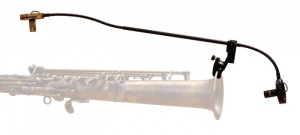
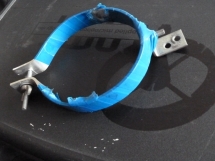
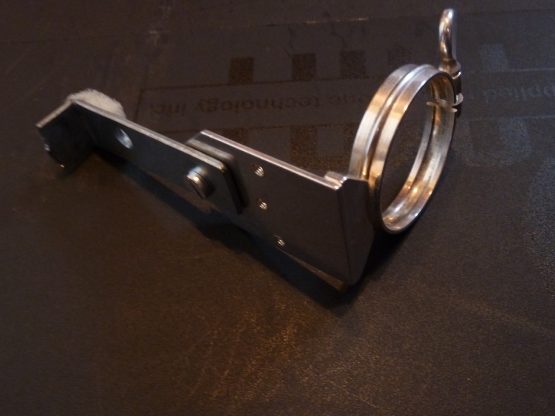
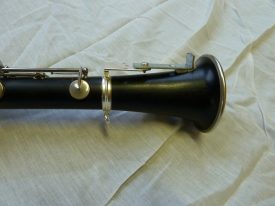
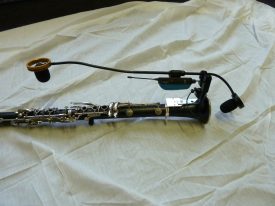
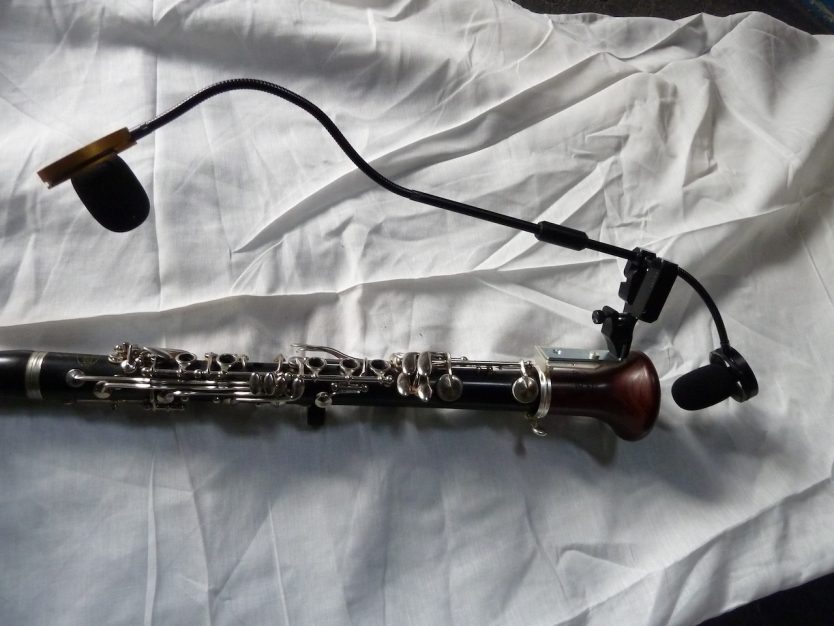
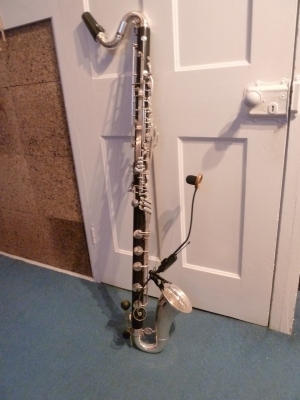
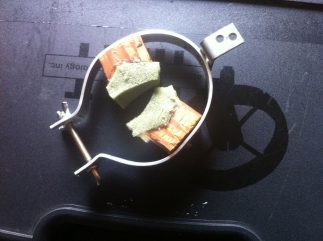
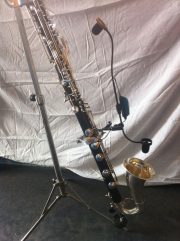
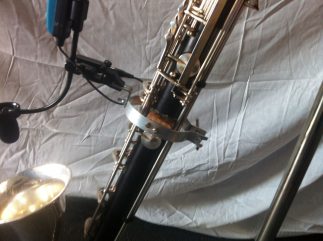
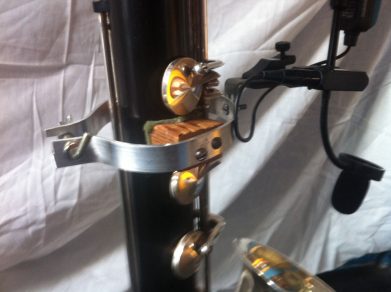
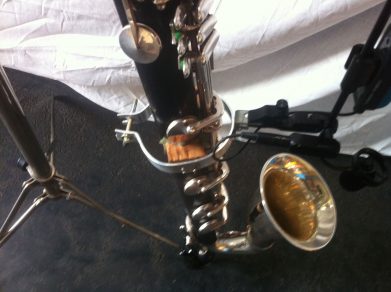
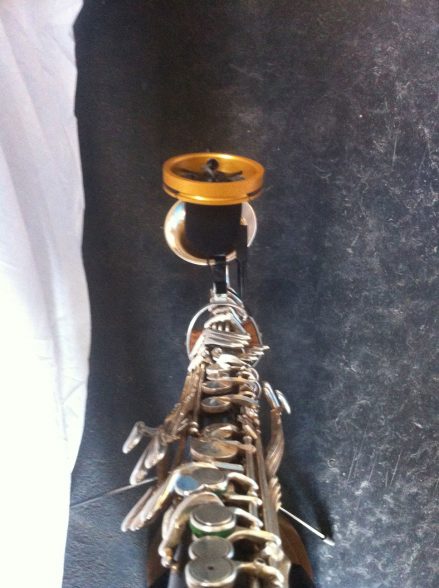
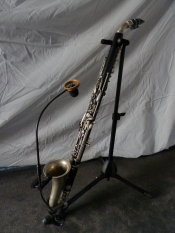
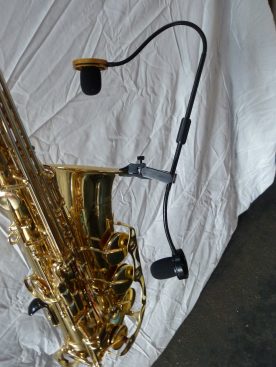
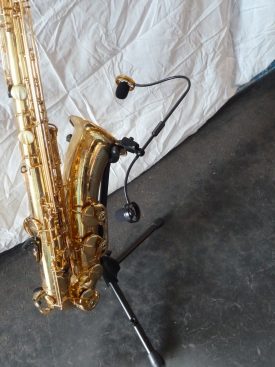
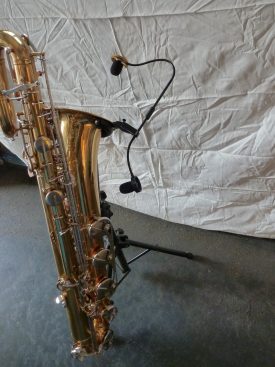
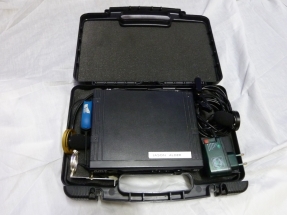
Phew, your post on micing is VERY thorough. I wish there was someone out there blogging about low brass micing and amplification! Btw. Mattis Cederberg of the WDR Big Band uses the Rumberger clari mic on his cimbasso! 😀 check out Siempre Queso Negro on Youtube…
Thanks Markus. Wow, that cimbasso… Never seen one before! Is it like a cylindrical tuba or valves contrabass trombone or something? The thing with mics and brass is that it’s a lot easier because all the sound is coming out the bell on the end, so you don’t have the problems of micing the fingers that woodwinds do. What you do need to think about is what type of mic works best for the instrument for frequency response and SPL rating, and the best position- distance, angle, pointed at the center of the bore or off-axis, etc- that all affect how it will sound.
Yep, it’s a contrabass valve trombone. In this case, a Swiss hand made $15k contrabass valve trombone…
And about brass microphone techniques… Yes, I’m aware of how to mic my trombone for decent traditional sound. What I’m looking for is more like unorthodox techniques 😉
Nice ! Do you know where I can fond it in France please ???
Thanks for your advice…
Hi Adrien, thanks for reading. I don’t know specifically any shops where you could buy in France, but I am sure there are some. But you can order online directly from AMT http://www.appliedmicrophone.com, but then you would probably have to pay some import tax. Otherwise you could order from the huge European musical warehouse http://www.thomann.de.
Hi Jason,
Great article!
I’m quite new in amplifying bass clarinet and sax. I have experience with microphones and I don’t like clip mics because you hear when you hit the keys.
I like the idea of Rumberger, but I don’t want to make a hole. I’m just wondering if the highest trill key of the bass clarinet (I barely use it) can be replace for the Rumberger. Like this we avoid to make an extra hole and we don’t need to spend money on a new neck.
What do you think?
Thank you.
josep
Hmm.. I had never considered that before, but I do use that key so it wouldn’t be an option for me. The biggest concern that comes to mind is whether the hole is the right size to fit the Rumberger, because I imagine that it’s too big. Perhaps if you could find a way to seal it in, like with some rubber tubing or something. But you need to make sure it completely seals, otherwise the instrument won’t respond correctly… like there’s a leaky pad… which is exactly what you’ve created. The other thing is how the positioning affects the sound. I haven’t played around with it myself, so I honestly can’t tell you whether it’s better for it to sit higher at the neck, or if it’s ok lower at that key. I also don’t know if it matters that it’s attached to the instrument below another hole (the register key). If you have access to a Rumberger or similar (you’re in NL, right? Alex Simu has one) to try it out, and are a bit resourceful, I’d say give it a try and let me know how it works!
Hi, thanks for the article!
and what about drill a bass clarinet mouthpiece and put a Rumberger on it? (in order to save a neck).
would be it an option?
That could also be an option. I’ve never tried one that close to the reed before and wonder how much extra noise it might pick up. Also, my mouthpieces are still pretty expensive so it would still incur quite a bit of extra expense… but still less than a new neck 🙂 If you have access to a Rumberger and a cheap extra mouthpiece, I’d say go for it and let me know how it works.
working
I’m gonna do that
and i’ll keep in touch
Hi Jason,
Thank you for all the valuable information that you published over two years ago and for your contributions to music. I hope this question is not obsolete. Why did you not select the AMT “System 1”? Did it fail to meet one of your criteria which are the same as mine, now that I am in about to purchase a mic system for my soprano and bass clarinets and my straight soprano sax. A chart from AMT shows the System 1 as excellent for bass clarinet, good for soprano clarinet and ok for soprano sax.
Hi Mike, thanks for your comment. I’d be interested in seeing this chart, I can’t seem to find it.
The System 1 is an old model that I don’t think they even sell anymore. I think it’s most similar to the current LS model. Its biggest problem is that it’s only 1 microphone, and bass clarinet needs to have 2 in a close-mic situation, and both clarinet and straight soprano sax are also best with 2. The other saxes are fine with just 1 because of the curve of the bell. Also, I think it was hard-wired, whereas the new models use the detachable cable technology enabling it to be used with a wireless system. AMT makes specific clarinet and bass clarinet mics, but they weren’t ideal for me because 1) They weren’t interchangeable amongst all the instruments and 2) The bass clarinet mic is very clunky and actually has 2 separate mics and outputs, whereas I wanted them summed into 1.
In my opinion, the TA2 was the best because, as the article says, it used two mics summed to one output, and I could swap them quickly between instruments with its alligator clip, rather than a more complex clamp like the clarinet WS model uses (which otherwise is very similar to the TA2).
If I were to buy one now I would go for the TA6, which is the same as the TA2, except one of the mics detaches and can be used on it’s own on alto, tenor, and bari sax like an LS model. I have made the TA2 work on all the saxes, but I admit it does look a bit funny the way I have to bend the goosenecks.
Greetings
I have an AMT mic…with mic on bell and mic on keys and clamp attachment. Worked and sounded great…until it stopped working after only a few years of light use. Un-fixable. Would never purchase one again.
Hello. Thanks so much for your post.
I have exactly the same needs – do you know if the TA6 can be detached for use as a single Sax mic quickly during live performance?
Also, could the Double microphone be attached to music stand in front when moving about the stage is not an issue?
Thanks again
Hi Tim, I’m not sure exactly as I haven’t actually used it myself. Based on the photos, I’m guessing the top and bottom capsule clip to each other via a mini-xlr connector, so to switch it to a single capsule mic, you’d need to pull it off, attach it to the clamp, and connect the cable. You might be able to keep single mic clamp attached to eliminate that step. I would probably recommend having a second cable so that rather than unplugging it from the double mic and then replugging into the single, you can eliminate a step and just plug it in into a different cable. It might be preferable to do this anyway so that the two instruments are on separate mixer channels, thus saving the sound engineer the hassle of changing the levels every time you switch horns. I guess you could attach the double mic to a music stand and turn the capsules around… depends on if you can get them into the right positions for the horn…
Pingback:Viga Music Tools Intramic: Clarinet Microphone (B-flat, Bass, & Contrabass) - Blog :: –– Jason Alder :: (Bass) Clarinetist
I used a Zoom H1 turned 90° to the side, about 1 m away from my bass clarinet.
The left channel was aiming the bell and the right channel to the upper third of the instrument, I convertet the recording to mono. The sound was very pleasing, I think You could also use the Zoom H1 (or a similar divice) as USB-mic.
Jan
For recording, yes that would work. Depending on the room you don’t even necessarily need to turn it sideways. But it’s not really a great option for a live mic, which is what I use clip-ons for. For recording I prefer other options.